

Entertaining the Gods
|
Japan is known for various performances, one of which is known as kagura. Literally meaning “entertaining the gods”, kagura is a religious ritual involving music and dance and dedicated to Shinto gods. Since ancient times, it has been performed at religious ceremonies, in which people pray for a bountiful harvest and to ward off illness and natural disasters.
The exact origins of kagura are not clear. However, it is said to have derived from a tale found in Kojiki, which is a record of mythologies and semi-historical accounts. The story describes how the goddess of the sun (Amaterasu) hid behind a rock, and many gods danced and played music in order to coax her out. The kagura performances we see today are mostly based on mythologies from historical records Kojiki and Nihongi, and usually involve battles between gods and demons. For example, legend has it that demons caused droughts and floods. Therefore, people would pray to the gods to defeat these demons. As such, the performances usually showcase a simple theme of gods defeating the demons. In the past, some kagura performances could last as long as three days. While it began as a religious ritual that was only performed by Shinto priests, it is now a popular form of entertainment that is performed by ordinary people. This significant change came about as priests were banned from performing kagura in the beginning of the Meiji period. The Meiji government deemed the ritual performance as unsuitable and undignified for Shinto priests. Thus, ordinary people such as farmers and fishermen began to take over the performing roles, while the Shinto priests taught them in order to pass on the tradition. As kagura spread across Japan, each region came to have their own evolved form. In particular, Iwami Kagura from the western part of Shimane prefecture remains popular today, with more than 130 active troupes. There are even children’s kagura groups, and some schools include it in the curriculum. Notably, Shimane prefecture is one of the prominent birthplaces of Japanese mythology and even known as the “province of the gods”. Iwami Kagura is characterised its fast-paced performances, colourful costumes, stories that are easy to follow, and may even feature dramatic pyrotechnics and smoke machines. One of the most popular myths to be featured in Iwami Kagura is the one of the Shinto storm god Susanoo rescuing Princess Inada from the eight-headed serpent Yamato-no-Orochi, by tricking it into getting drunk on wine. The story certainly makes for a dynamic and spectacular show, and several elements further contribute to it. For example, the vibrant costumes are handmade with real silver and gold threads embroidered, and each can weigh up to 20 kilograms. The biggest costume is naturally the serpent costume, made from bamboo dried for one year and local Sekishu washi paper, which is recognised as a UNESCO Intangible Cultural Heritage. It can stretch out to as long as 17 metres, and weighs around 12 kilograms. Another important element is the mask, similarly made from Sekishu washi paper, which is both light and durable. Besides that, the accompanying music helps to set the pace. There are usually four musicians, each playing the flute, small drum, cymbals and large drum respectively. The member playing the large drum would also sing. There are regular Iwami Kagura performances on weekend or weekday evenings at a variety of venues, and some are free too. If you ever visit Shimane, why not take the opportunity to enjoy this unique tradition? |
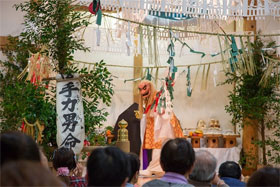 © Japan Up Close 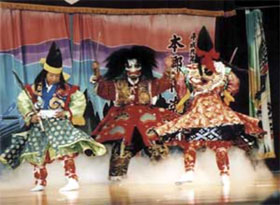 © Web Japan 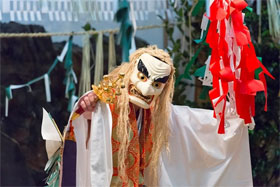 © Japan Up Close 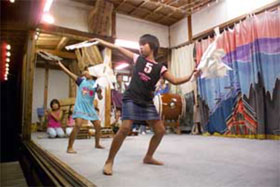 © Web Japan 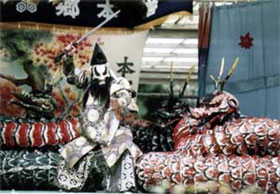 © Web Japan 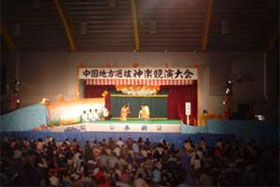 © Web Japan |
Resources
|
“Kagura”. 2007. Kids Web Japan. Accessed 17 July. https://web-japan.org/kidsweb/meet/kagura/kagura01.html. Phan, Ming Yen. 2019. “Iwami Kagura: Ritual Theatre From The Province Of The Gods”. The Esplanade Co Ltd. https://www.esplanade.com/offstage/arts/iwami-kagura-ritual-theatre-from-the-province-of-the-gods. “Iwami Kagura – Dancing for the Gods”. 2017. Japan House London. Accessed 17 July. https://www.japanhouselondon.uk/discover/iwami-kagura/. “Iwami Kagura”. 2013. Executive Office of the Iwami Tourism Promotion Association. Accessed 17 July. https://www.all-iwami.com/en/kagura/wk/. “Iwami Kagura – Living Tradition”. 2011. Shimane Prefecture. Accessed 17 July. https://www.kankou-shimane.com/en/highlights/9637. |
|
Japan Creative Centre 4 Nassim Road, Singapore 258372 +65 6737 0434 / jcc@sn.mofa.go.jp https://www.sg.emb-japan.go.jp/JCC/ Nearest parking at Orchard Hotel & Delphi Orchard |
 |